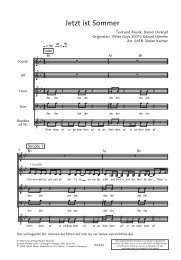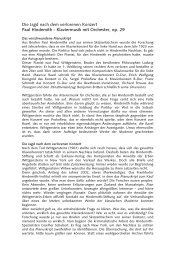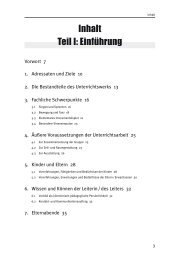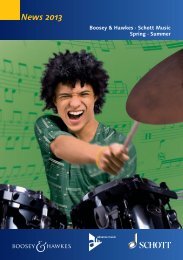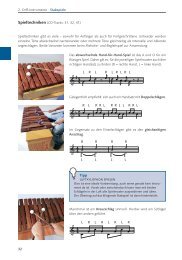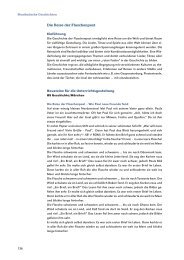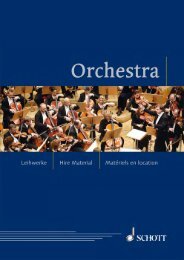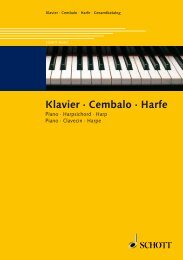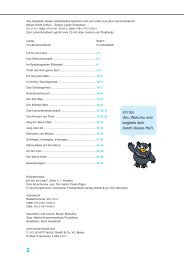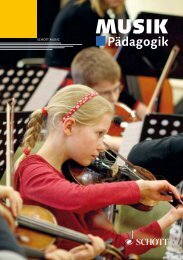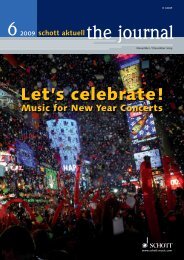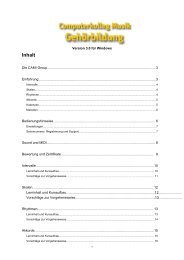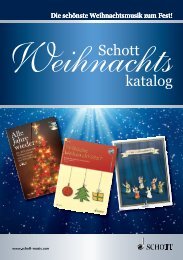HANS WERNER HENZE - Schott Music
HANS WERNER HENZE - Schott Music
HANS WERNER HENZE - Schott Music
Erfolgreiche ePaper selbst erstellen
Machen Sie aus Ihren PDF Publikationen ein blätterbares Flipbook mit unserer einzigartigen Google optimierten e-Paper Software.
I<br />
m Jahr 1928 gründeten Erich Bormann und Max<br />
See ein Opernstudio an der Bayerischen Staatsoper,<br />
das jungen Komponisten die Chance eröffnen<br />
wollte, sich mit der damals populären Form der<br />
Kurzoper zu befassen. Für dieses Studio entstand Karl<br />
Amadeus Hartmanns fünfteiliger Zyklus von Kammeropern<br />
unter dem Übertitel Wachsfigurenkabinett<br />
mit den Einzelteilen Leben und Sterben des heiligen<br />
Teufels, Der Mann, der vom Tode auferstand, Chaplin-<br />
Ford-Trott, Fürwahr…?! und Die Witwe von Ephesus.<br />
Der Mann, der vom Tode auferstand schildert den Alptraum<br />
eines Kapitalisten, der im Radio eine Revolutionsoper<br />
hört und sich in die Angst vor einer wirklich<br />
stattfindenden Revolte hineinsteigert.<br />
Fürwahr…?! ist eine Szene von Valentin’schem Humor<br />
– Vater und Sohn treffen betrunken vor der Wohnungstür<br />
aufeinander und behaupten wechselseitig,<br />
der jeweils andere wohne hier nicht. Ein Schutzmann<br />
kann die Situation nicht lösen und beide beschließen,<br />
die Hausherrin entscheiden zu lassen, wer berechtigt<br />
ist, die Tür aufzuschließen. Prompt klärt sich alles auf.<br />
Zu einer Aufführung des Zyklus kam es zu Lebzeiten<br />
von Hartmann nicht. Vollständige Partituren existierten<br />
nur vom ersten und letzten Teil, ansonsten lagen<br />
handschriftliche Klavierskizzen aller fünf Stücke und<br />
ein durchschossener Klavierauszug des ersten Teils<br />
vor. Für die auf Anregung von Hans Werner Henze<br />
bei der 1. Münchener Biennale 1988 stattgefundene<br />
Uraufführung wurden neben Henze die Komponisten<br />
Wilfried Hiller und Günter Bialas mit der Vervollständigung<br />
der Partituren beauftragt.<br />
I<br />
n 1928, Erich Bormann and Max See established<br />
an opera studio at the Bayerische Staatsoper to<br />
provide an opportunity for young composers to<br />
focus on the then popular form of short opera. Karl<br />
Amadeus Hartmann’s five-part cycle of chamber<br />
operas under the general title Wachsfigurenkabinett<br />
(Waxworks) was composed for this opera studio. The<br />
titles of the individual works are: Leben und Sterben<br />
des heiligen Teufels, Der Mann, der vom Tode auferstand,<br />
Chaplin-Ford-Trott, Fürwahr…?! and Die Witwe<br />
von Ephesus.<br />
Der Mann, der vom Tode auferstand depicts the nightmare<br />
of a capitalist who listens to a revolution opera<br />
on the radio and becomes increasingly agitated in his<br />
fear of an actual revolution taking place.<br />
Fürwahr…?! is a scene reminiscent of the humour of<br />
Karl Valentin – father and son meet outside the front<br />
door in a drunken state and both insist that the other<br />
does not live here. A police constable is unable to<br />
solve the problem and both decide that the lady of<br />
the house should determine who is justified in opening<br />
the front door. Immediately all becomes clear.<br />
The cycle was never performed in its entirety during<br />
Hartmann’s lifetime. Only the first and last parts exist<br />
as complete scores: handwritten piano sketches of<br />
all five parts have additionally survived which are interleaved<br />
with a piano reduction of the first section.<br />
Following encouragement on the part of Hans Werner<br />
Henze for the first performance of the cycle at the<br />
1st Biennale festival in Munich in 1988, the composers<br />
Wilfried Hiller and Günter Bialas were additionally<br />
commissioned to complete the scores together with<br />
Henze.<br />
“ “<br />
Beide Werke sind in Karl Amadeus Hartmanns<br />
Skizzen relativ unvollkommen. Um eine Aufführung<br />
möglich zu machen, habe ich versucht, das<br />
Hartmann’sche Grundmaterial zu variieren und mit<br />
diesen Variationen die fehlenden Teile auszufüllen.<br />
In den Particell-Skizzen für Fürwahr…?! findet sich die<br />
Instrumentation minutiös vorgezeichnet. Daraus war<br />
zu entnehmen, dass Hartmann die skizzierten Noten<br />
für ziemlich endgültig gehalten hatte. Nun habe ich<br />
aber doch, als Freund und Kenner Hartmanns und<br />
seiner Musik, das harmonische Bild ein wenig verschärft,<br />
zugespitzt […]. Fremde Noten aber habe ich<br />
nicht eingeführt, ich konnte mit den Hartmann’schen<br />
auskommen. Zuweilen lasse ich die eine oder die andere<br />
Note länger tönen als im Particell vorgeschrieben,<br />
oder ein Quartfuß wird eingeschoben, um einem<br />
Akkord mehr Licht zu machen, und es kann auch<br />
schon einmal vorkommen, dass ich einzelne Noten<br />
aus einer Folge oktav-versetzt habe: was auch immer<br />
es sei, es ist alles gemacht worden, um die ursprüngliche<br />
Klangvorstellung Hartmanns getreulich wiederzugeben<br />
und um den Witz und den Humor, der in<br />
diesem kleinen Opus enthalten ist, wieder lebendig<br />
zu machen.<br />
Both pieces in Karl Amadeus Hartmann’s<br />
sketches appear rather incomplete. In order to<br />
make a performance possible, I have tried to vary the<br />
composer’s basic material and to fill the gaps in the<br />
sketches with these variations.<br />
In the short score sketches of Fürwahr…?! [Indeed…?!]<br />
the instrumentation has been meticulously<br />
laid down. It is clear from this instrumentation that<br />
Hartmann considered the sketched music to be more<br />
or less the final version. But being a friend and well<br />
acquainted with Hartmann and his music I still intensified<br />
the harmonic picture a little […]. I did not,<br />
however, introduce foreign notes. I could manage<br />
Hartmann’s notes. Sometimes I made a note sound<br />
longer than is indicated in the short score or doubled<br />
it at the forth above to brighten a certain chord, and I<br />
sometimes made an octave transposition of individual<br />
notes from a sequence. But whatever I did was done<br />
to give a faithful version of Hartmann’s original tonal<br />
conception and to revive the wit and humour that are<br />
contained in this short opus.<br />
59



